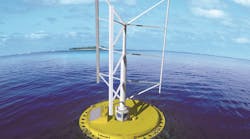Power Electronics Technology has presented articles on the use of ocean currents to generate electricity (September 2010) as well as articles in 2006, 2007, 2008, 2010, and 2011 that described use of wind to produce electricity. Now, we find that the Mitsui Ocean Development & Engineering Company, MODEC, developed a technology that combines both wind and ocean currents to produce electricity. MODEC is an offshore technology company specializing in floating oil and gas production systems.
MODEC's "SKWID" converts two inexhaustible ocean energy sources into usable electric power. By harvesting the renewable energy from never-ending currents and strong winds, the SKWID provides cost-effective power with minimal environmental impact. It is said to be the world's first hybrid turbine capable of maximizing the harvesting of ocean energy from wind and current.
SKWID, or Savonius Keel and Wind Turbine Darrieus, is a floating power generation system scheduled for testing off the coast of Japan this year (Fig. 1). It is a 29 m diameter wind and ocean current power generation system. Its 63 m total length is divided into 47 m from its wind turbine to floater draft and 16 m from the floater draft to the bottom of the current turbine.
The SKWID electrical system employs a synchronous generator followed by a dc-to-ac inverter to produce 6600Vac to power the load. Backup batteries provide auxiliary power for those occasions when there is insufficient wind or tidal currents.
In operation, a Savonius tidal turbine and a Darrieus vertical-axis wind turbine connect with a central gearbox/generator to generate power from ocean currents and wind. Calculated power output from the wind turbine is 500kW with 13 meters/second (m/s) winds and up to 900kW with 16m/s wind velocities. Its maximum rotating speed is 58 rpm. Its tidal current turbine output is 50kW at a velocity of 1.69 m/s and its maximum rotating speed is 1.5 rpm.
The Savonius tidal current turbine has split-cylinder-shaped buckets that can harness any weak current. It rotates in one direction regardless of current direction. In addition, this turbine is insensitive to marine growth on the buckets and is harmless to the marine ecosystem, as it rotates slowly at the speed of the current. Plus, the Savonius current turbine acts as a ballast, making the floating power generation assembly self-righting. Plus, the tidal turbine provides a jump start for the wind turbine when breezes are light.
The 15-meter diameter Savonius turbine is a drag-type device, consisting of two scoops. Looking down on the rotor from above, a two-scoop machine would look like an "S" shape in cross section. Because of the curvature, the scoops experience less drag when moving against the wind than when moving with the wind. Differential drag causes the Savonius turbine to spin.
The 24-meter diameter Darrieus wind turbine is a three-bladed vertical axis wind turbine (VAWT). This turbine consists of a number of aerofoils vertically mounted on a rotating shaft. This Darrieus VAWT has been modeled to capture twice the energy from its rectangular swept area as a similarly dimensioned conventional onshore turbine. Therefore, for the same area it can deliver far more power than a conventional wind farm. The omnidirectional Darrieus turbine rotates regardless of the wind direction.
The float structure supports the power generation assembly with a set of rubber mounts like a gimbal to isolate the power generation assembly from wave motion. The SKWID's design allows it to survive rough seas. Its deck-mounted generator and below-deck tidal turbine provides the platform with a low center of gravity. Plus, its flexible rubber mounts allow it to rock back and forth with waves while the turbine and associated machinery are stable and upright. Due to the location of its generator, the system has excellent stability, as well as excellent maintainability with easy access.


